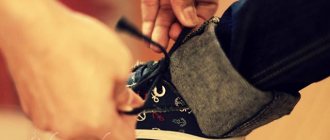Most often, when complaining about incorrect pronunciation, parents talk about their child’s inability to pronounce a particular letter. In fact, we should be talking about the pronunciation of a sound, because a letter is only a graphic representation of pronounced sounds. But in any case, there is a speech therapy problem that needs to be corrected. Quite often, children do not pronounce complex sounds, which include [sh]. However, almost any parent can teach their child to correctly pronounce the difficult letter Ш.
Pronunciation check
Parents can check the correct pronunciation of sounds by their child themselves.
There are different tests for this. You can use the same technique with which speech therapists evaluate a child’s speech at the first appointment: ask to pronounce words or syllables containing hissing sounds (for example, noise, school, came, bumblebee). To pronounce W correctly, the tongue should be like a ladle, located in the center of the oral cavity, and not stick out forward. It is important that the tip points upward.
The verification should be carried out in stages:
- The first stage is a general check. You need to ask the child to say a couple of easy sentences that contain words with a letter (for example, “you should wear a scarf in winter,” “the cat caught the mouse”). Next, you need to move on to the pronunciation of individual words (edge, hat, good, porridge);
- the second stage is checking the sound of Ш in isolation. Attention is paid to syllables. You need to ask the baby to say “OSH”, “SHA”, “OSHO”, “USHU”. This will allow you to find out how well the child can pronounce sounds. It happens that such a check reveals problems with vowel sounds. Therefore, it is recommended to vary the syllables;
- the third stage is testing in individual syllables with voiceless and voiced consonants.
To check the pronunciation of different sounds, there are special cards with bright pictures. They are sold in children's stores. Thanks to such cards, the test can be carried out in the form of an enjoyable game.
Automation Ш in sentences
To practice pure pronunciation, the child should repeat the sentences. This exercise is considered difficult.
- Alyosha and Natasha are walking happily.
- Misha wants to buy a big ball.
- Dasha hangs the scarf on a new hanger.
- Sasha rides a black horse.
- They are sewing a new fur coat for Mishutka.
- The fur coat has seams.
- Wear a gray fur coat and hat today.
- Yasha, wash your neck and ears.
- The car was fitted with new black tires.
- Natasha, give me a turret.
- Katyusha, put on your galoshes so your feet don’t get wet [w].
- Nastyusha used a sewing machine to sew 2 hats, 2 scarves and one fur coat for the doll.
- The baby has a pencil.
- The mouse rustles a piece of paper [w].
- The kid picked lilies of the valley.
- Our hut is very good.
- Katyusha sewed a shirt, but was in a hurry.
- Masha and Sasha followed Glasha.
- My books [w] are in the closet.
- There is a green frog sitting on the path [w].
- Pasha and I play chess.
- The cat runs after the mouse.
- Mishka got a bump on the top of his head.
- Our cat loves to play with a reel.
- I found different coils in my grandmother's box.
- Valyusha loves flatbreads and cheesecakes.
- A seamstress will sew a parachute for a toy on a machine.
Causes
The main reason that a child cannot speak hissing sounds correctly is the way the parents communicate with the baby. Many adults deliberately copy the speech of a child, speaking to him in a childish way. Thus, the child hears the incorrect pronunciation and gets used to precisely this manner of producing the sound sh. That is why experts strongly recommend that parents speak to their children correctly.
In addition to the parental desire to imitate baby babble, some structural features of the articulatory apparatus play an important role in the production of the sound sh, which include the following points:
- tongue movement is limited due to the shortened hyoid ligament;
- articulation is affected by the size of the lips (too thin or full) and the size of the tongue (too large or small);
- dental anomalies;
- disruption of the auditory canal.
In most cases, a violation of the production of the sound w can be quite easily corrected at home with regular and careful work with the child. In some cases, children who have problems pronouncing hissing words will be helped by a speech therapist.
What prevents a child from “hissing”?
There are two groups of reasons why babies fail to pronounce the sound “Ш” correctly. Physiological reasons include:
- Insufficient development and immobility of the articulatory apparatus;
- Malocclusion (often caused by prolonged use of a pacifier);
- Short frenulum of the tongue;
- High palate;
- Oral diseases;
- Difficulties in phonemic perception (the child does not distinguish some sounds by ear);
- Hearing impairment;
The second group of factors are the mistakes of adults who are around the child.
- “Lisping” from adults;
- Incorrect pronunciation by adults (children always repeat after us).
Why do you have problems pronouncing hissing sounds?
There are various reasons for incorrect pronunciation. Most often, the problem is caused by weakness of the tongue muscles - the organ, instead of rising up when pronouncing words with the letter Ш, lies at the bottom of the mouth.
Common problems with the pronunciation of hissing sounds:
- replacing Sh with T or the absence of a hissing sound in speech . For example, instead of the word “whisper” the child says “tepot”, and instead of “bear” - “mika”. This may be caused by impaired phonemic hearing or early age;
- replacing Sh with F. For example, a child says “fifka” instead of “bump.” This disorder is called labiodental sigmatism. The problem is a shortened hyoid frenulum, too active lip work, and impaired phonemic perception;
- replacing Sh with S. For example, a child says not “school”, but “skola”. This problem is called whistling sigmatism. It is caused by a violation of phonemic perception;
- lisp . It occurs if the tongue does not follow the shape of the ladle and is pushed between the lower and upper incisors, forming a gap. The air stream is scattered and weak when pronouncing hissing sounds;
- Instead of Ш, a squelching sound is heard . This problem is called lateral sigmatism. In this case, one of the corners of the lips is slightly pulled back or lowered. Sometimes the child has a slight displacement of the lower jaw to the right or left. In this case, when pronouncing the sound Ш, the air stream comes out along the edges of the tongue or goes sideways;
- Instead of Ш, snoring is heard. This disorder is called nasal sigmatism. In the presence of such a problem, the speech organs occupy a neutral position, the tongue is pulled deep into the mouth, its back is raised and connected to the soft palate, and the edges are lowered. The air stream passes through the nasal cavity. This happens when there is excessive tension on the back of the tongue.
Production from R
You can also set from P if the sound is well automated. When pronouncing a sound, you need to hold the probe slightly under the tip so that it does not vibrate. Or ask the child to say RRRSH. It’s good to first do the dynamic exercise “fungus - sail”, then suck your tongue to the palate, then release the middle part in the shape of a cup. It is advisable to pronounce the sound R not voiced, if in the end you want to get a Ш, a voiced sound can result in a J or a H, which is also, in general, not bad.
Articulation
The key to good pronunciation is the correct articulation of the sounds sh and zh. To teach a child to pronounce the letters sh and z correctly, it is necessary to study one method of articulation, since the speech apparatus works almost identically when pronouncing both letters. So, in order to correctly pronounce the letter w, it is necessary to work with the articulatory apparatus as follows:
- the baby's lips should be slightly pushed forward in the shape of a tube;
- the tip of the tongue is raised to the palate so that a small gap remains between them;
- the lateral edges of the child’s tongue are pressed against the upper outer teeth, giving the tongue the shape of a cup;
- a stream of air easily passes through the unused vocal cords, creating the necessary sound.
In order to understand how to teach a child to say the letter z, it is necessary to resort to the articulation described above, while connecting the vibrations of the vocal cords. Regular exercises for making sounds are very important. These exercises can be done with a speech therapist or at home.
Learning to pronounce “Sh” correctly
It is recommended to start practicing the sound “Ш” in isolation. The most effective way is the method of setting from the sound “T”, provided that the child pronounces it correctly and clearly. The baby is asked to pronounce the combination of sounds “t-s-s” in the same way as it is pronounced when he is called for silence.
After several attempts, you need to complicate the task by offering to do the same, but with your tongue hidden behind your teeth. The result will be hissing. To make the exercise seem more interesting, you can offer an imitation of the hissing of a cat or the rustling of the wind, or the sound of a descending ball.
There is no need to demand instant results from your child and rush to move on to more complex tasks. It is necessary to wait for a positive result by training hissing.
Articulation gymnastics and its features
Before each lesson, it is necessary to sit the child down, making sure that he sits upright. All distracting objects are removed, the TV is turned off. An excellent option would be to practice in front of a mirror so that the child can see not only the articulation of the adult sitting in front of him, but also his own.
Articulation exercise in front of a mirror
- A strict sequence of exercises and regularity are the main principles that ensure the effectiveness of exercises for the speech organs. It is best to use ready-made sets of exercises that teach you to pronounce certain sounds. They are selected taking into account the age and other characteristics of the child.
- In order for the child to participate more willingly in the lesson, it is best to teach him to speak in a playful way, supplementing him with interesting riddles for the desired letter, songs, nursery rhymes and jokes
- Do not overload your child with exercises. It is better to do no more than 2-3 in one lesson, but with multiple repetitions - this makes it easier to teach the child new things.
- New exercises starting with the letter “c” can be introduced only after the child has already thoroughly mastered all the previous ones and copes with them without much effort.
- In order for the child to have the opportunity to see and correctly understand the technique of the exercises proposed to him and pronounce sounds, it is best to use a mirror for practice.
- When performing exercises, it is important to monitor the symmetry of the child’s face, the accuracy and smoothness of movements, and the correct pace. Without this, the effectiveness of the exercises will be minimized.
Automation Ш at the beginning of a word
Following the adult, the child says: washer, gang, skank, jackal, shawl, scarf, chocolate, Scotsman, highway, hair, shorts, whisper, screen, chimpanzee, wide, fizzy, sewing, cipher, show, shopping, shock, shock, shaker, shocker, lisp, sheriff, six, sixteen, gear, patronage, sheffer, toss, moor, squall, locker, barrier, hat, spanking, shmotnik, smack, lace, spy, spinach, syringe, sprats, cheat sheet, putty, headquarters, staff, tripod, adit.
Lessons on making the sound “sh”
A child's education cannot be achieved without play. First you need to check your attentiveness and clarity of perception. Say words with and without the letter “sh” in any order. Invite your child to clap his hands when he hears words that contain the sound “sh”.
Be sure to praise your child for his successes.
Ask your child to use his hand to depict a hissing snake, which must follow the drawn labyrinth to the goal.
Remember together where else you can hear hissing sounds - the rustling of fallen leaves under your feet, the hiss of a cat, the rustle of a frightened mouse, the rustling of leaves in the wind.
To reinforce the sound, first use syllables and words, and then tongue twisters, children's poems and pure tongue twisters. Pictures depicting objects that have the letter “sh” in their names will be of great help in automating pronunciation.
You need to start learning the correct pronunciation of the sound “sh” with articulation exercises. Then, with the help of games and activities, you can consolidate the achieved result.
We teach a child to say the sound [Ш] quickly
An individual speech therapy session on sound production [Ш] always begins with articulation and breathing exercises. This is necessary to create a basis for correct pronunciation.
Sound production
A simple way to make the sound [Ш] is from the correct [S]. To do this, you need to take a spatula and ask the child to say “SA-SA-SA”, at which time you need to lift the tongue with the tool.
You can try to act by imitation. They bring their index finger to their lips and say: “When mom is sleeping, the baby says, “quiet, quiet shhhhh.”
After calling an isolated sound, the child is shown the “hissing goose” symbol, which will indicate a new sound.
Automation
Individual lessons on sound automation [Ш] are conducted using different materials. You can add walking games, puzzles and other interesting exercise equipment. All this will diversify the lesson.
Important! It is useful to combine automation with physical exercise. For example, with jumping or active games - leapfrog, ball and others.
The sequence of automation cannot be broken - forward syllables, reverse syllables, words, phrases, sentences, poems and tongue twisters.
Exercises for pronouncing sounds
Initially, it is recommended to prepare cards that will depict animals and objects that have problematic letters at the beginning, middle or end. You need to observe whether the pronunciation of a complex letter always turns out to be problematic, or in some positions.
pronounce the letter “Ш” using a little trick: ask the child to pronounce the letter “s”, and use a spoon to lift the baby’s tongue towards the sky. The sound will be “sh”. The letter is fixed with the words: awl, whisper, ears, noise; sentences: Our Masha rustles; and also in verse:
“Dear bear, Nice bear, Our bear is all made of plush.”
Gaming techniques
To make the lessons more interesting and entertaining, prepare pictures or toys with “hissing” animals (goose, snake) and objects (a flat tire, a balloon, a ball). Show the goose how it stretches its neck and hisses, as if it wants to pinch a child. The boy was playing with a balloon, and it got stuck on a branch. And here you can use “sound tracks” - draw the path of the snake, how it crawls and hisses. A car is driving down the road with a flat tire.
After the sound is established and the baby can pronounce it more or less independently, you can move on to consolidating it in syllables, words and sentences. And at the same time try to place other hissing words: Ж, Ш, Ш, differentiating them from each other and from the whistling ones. All these exercises develop phonemic awareness very well, and the exercises “find the place of a sound in a word” or “come up with a word for this sound” also involve sound-letter analysis and synthesis, which is a good preparation for school. Much more useful than forcing your baby to read.
This concludes writing this article. There will be others where I will continue to talk about fixing the sound Ш and distinguishing it from S. So subscribe to new articles to always stay up to date. Share your impressions on social networks, and also write about your experience in the comments on the blog. Best wishes!
Exercises for the development of the speech apparatus
When pronouncing the sound “sh” correctly, the tongue should occupy a certain position in the mouth. It is spread wide, and the tip is raised towards the hard palate, and forms a gap with it behind the upper teeth. The lateral edges of the tongue are pressed against the upper incisors.
How to teach a child to say the letter “sh” at home - do tongue exercises with him
If the baby cannot pronounce the sound correctly, articulation gymnastics is needed. For home exercises, special exercises are used that train the speech apparatus. The child should perform them in front of the mirror to see how he can repeat what his mother shows:
- “fence” - the baby must close his teeth and show his mother what kind of “fence” he has made;
- “tube” - the child stretches his lips forward like a tube, then quickly alternates between the “tube” and “fence” exercises;
- “lazy tongue” - the tongue needs to be stuck out of the mouth and placed on the lower lip, completely relaxed;
- “bucket” - we bend the relaxed tongue up and place it behind the upper teeth, blow on it, which produces the sound “sh”.
Teaching your child to pronounce correctly
Parents whose children pronounce hissing sounds incorrectly are interested in how to teach their child to pronounce the letter Ш at home.
Speech therapists have developed exercises that help cope with this problem. The lesson consists of two stages: warm-up and sound production. In order for articulatory gymnastics to give a quick positive result, you need to perform it daily for 5-10 minutes.
It is necessary to show diligence and perseverance, praise the baby for success, and encourage him to do exercises.
Warm-up
Before you start performing the main complex, you need to warm up. This is necessary to prepare the oral cavity for the production of the sound Ш.
Warm-up consists of a number of simple exercises:
- place your tongue on your lower lip. Hold this position for 15 seconds;
- make a cup out of your tongue. Stay in this position for 10 counts. Relax. Make a cup out of your tongue again. This exercise trains muscle tissue well;
- click your tongue. This should be done slowly, stretching out the process;
- form a cup with your tongue, gently lower and lift it. This movement must be performed slowly and smoothly;
- alternately pronounce the sounds O and U, gesturing as much as possible with your lips (making a large circle out of them, folding them into a tube);
- make a narrow tube out of your lips and then smile widely;
- smoothly raise the tongue to the upper lip and lower it to the lower lip;
- Close your jaw, stretch your lips forward and form a kind of rectangle with them. Stay in this position for 10-15 seconds;
- lick your upper lip. This trains the upper elevation of the tongue.
Breathing exercises can prepare a child to produce the sound Ш. She teaches the baby to form the correct air stream.
The essence of breathing exercises is to perform the following exercises:
- blow on feathers, candles, pinwheels;
- try to blow a foam ball or a piece of cotton wool into the gate created for this (you can use a cardboard box);
- spread your tongue on your lower lip. Blow on the protruding tip so that the air stream passes through the center;
- Place a cotton ball on the tip of your nose. Push your lower lip forward and blow upward. You need to remove the cotton wool from your nose without using your hands, using the air flow.
It is recommended to perform all exercises in front of a mirror. During training, you can play children's songs and tell interesting stories.
Sound production
After completing breathing and articulation exercises, you can begin producing hissing sounds. There are various exercises that orient the child to the correct pronunciation of words with the letter Sh.
An effective complex for combating speech disorders:
- free flight . Make a cup out of your tongue and try to stick it out of your mouth. You need to put a small piece of cotton wool on your nose. As you exhale, the air will be pushed away from the wall of the tongue cup and rise upward, removing the cotton wool. This exercise is very simple and effective. It is especially recommended for children with a lisp;
- moving cup. Use your tongue to form a cup and begin to move it: raise and lower the edges;
- pie _ Open your mouth and place your tongue on your lower lip. Raise the side walls of the tongue so that a depression is formed along the central axis. Hold for 5-10 seconds. The exercise is aimed at strengthening the muscles of the tongue, making its lateral walls more mobile;
- ship at sea . Fold your tongue into a cup shape, lift it and hold it for 1-3 seconds, then lower it and fix it in this position for a short time;
- smile . Open your mouth and smile widely. Extend your tongue forward, placing the tip on your lower lip and the sides touching the corners of your mouth. Stay in this position for a few seconds. The exercise relaxes the tongue well. It helps in producing not only the sound Ш, but also Ж;
- swing . Open your mouth and smile. The tongue should be relaxed, flat and wide. Perform the following movements with your tongue alternately: reach to the ceiling, to the sides, to the upper and lower lips, touch the incisors, climb between the teeth and lip, touch the alveoli with the tip;
- painter _ Open your mouth slightly, smile slightly, relax your lips and fixate in this position. Imagine that the tip of your tongue is a painter’s brush, and the sky is a wall that needs to be painted. The tongue must be moved from the larynx to the teeth and back, without moving it outside the oral cavity. The exercise helps strengthen tongue control.
To pronounce complex sounds, not only production is important, but also automation. Therefore, when the child learns to pronounce Sh, you will need to move on to reinforcement exercises.










